I love learning new things, especially new cooking things. Be it techniques, flavors, ingredients, I love it. The world is so full of delicious and unique goodies, we would need to live several lifetimes in order to appreciate them all. There is a flower/plant that is very popular in Panama, the Caribbean and Mexico. In Panama and the Caribbean it is known as Saril or Red Sorrel. In Mexico, they call it Flor de Jamaica (Jamaican flower) and they use it for their aguas frescas–essentially, flavored (infused) waters.
These next 3 shots were taken by Peter, Mr. P. de Panama. A US expat living in my little country, who kindly allowed me to use his shots in exchange for the link to the recipe featuring them. I think I got the best end of that deal. Definitely take some time to visit his Flickrstream, he has some awesome photos here.
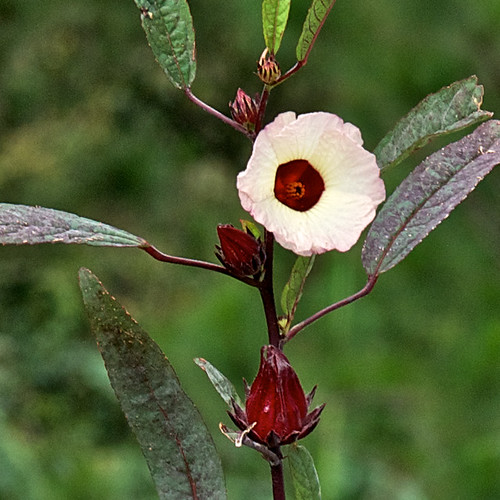
Saril bush, flower and ...the thing you make the juice with
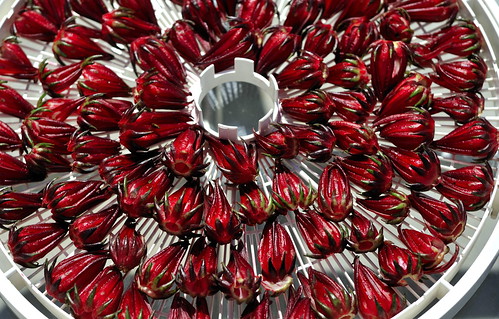
Similarly, I’ve been drinking Ponche de Saril (Saril punch) since I was a little kid; my mom and aunts would sit around for hours piting the flowers, then they would steep them with lots of ginger. To serve it, sugar and sometimes lime juice was added and then the drink is poured over lots of ice. It is one of the most beautiful and refreshing things you’ll ever drink, an awesome combination of tartness and zing. My mouth is watering just thinking about it.
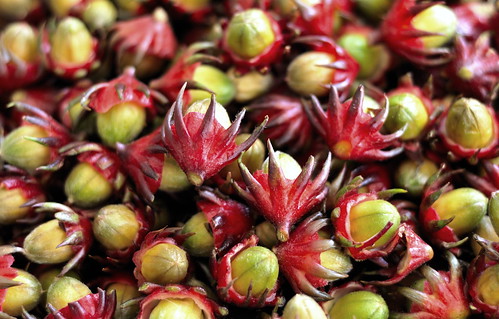
the pits!
That was the only use I was aware of for this flower, a relative of the common hibiscus plant. Recently, I read a post by one of my fave foodies, Lesley over at The Mija Chronicles. She used the reconstituted flowers to make quesadillas, then I discovered she has a fascination with the little flower and has prepared and eaten many dishes incorporating it. To say I was intrigued does not cover it. I couldn’t get it out of my mind. The possibilities seemed endless once I realized the genius of exploiting the flavors of the miracle flower. What to do…?
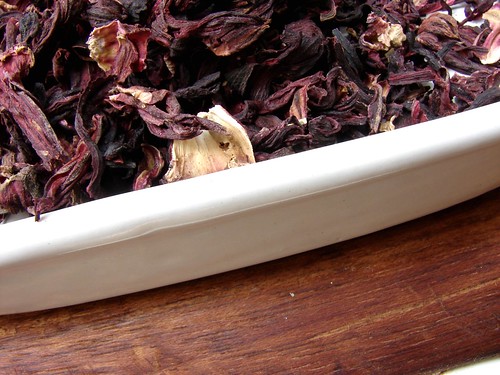
As you can see, the flower is a bright purplish red, the color intensifies when dried. The liquid, broth, tea, water, whatever we should call it, is a beautiful ruby red, a bit more intense than the color of cranberry juice. I wanted to make sure that the dish I created continued to pay homage to the vibrancy of the flower’s color. Saril’s flavor profile could be compared to that of fresh cranberries, I guess. Except, not as tart, giving way to a slight sweetness along the way. Again, I needed to preserve those flavors in the final product: chicken would open itself up to the flavors. A bit of heat and we would be golden. Want to see?
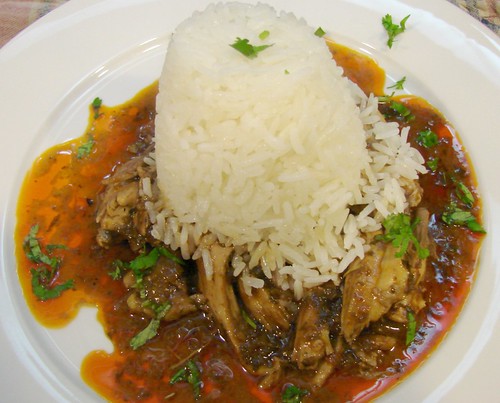
Chicken in Saril and Ancho Sauce
For the chicken
1 whole chicken, cleaned
2 carrots, halved
1/2 cilantro bunch
4 cloves garlic, whole
1 tbsp Herbs d’Provence
1 tbsp sea salt
Water
Remove the innards from the bird’s cavity and rinse the chicken under cold tap water. Place all the ingredients, except for the chicken and water in a stockpot, rest the chicken over them, then fill the pot with enough water to completely cover and submerge the chicken. Place on the stove on high heat until it comes to a boil. Once it boils, lower the temperature just enough to keep it at a slow boil (about medium-high flame) and allow it to cook for another 20 minutes.
At the end of the 20 minutes, turn off the heat and cover with a tight-fitting lid. Let it steam for another 30-45 minutes. Remove the chicken to cool and reserve the broth. This will result in the most beautiful, flavorful, moist chicken meat ever and the broth is amazing. Once the chicken has cooled, break the chicken into pieces and remove the meat from the bones into bite-size pieces. Set aside.
For the sauce
2 cps reserved broth
2 ancho chilies, whole
2/3 cp dried saril
2 tbsp raspadura or dark brown sugar
1-2 tbsp olive oil
1 yellow onion, diced
2 cloves garlic, finely chopped
1/2 cp cilantro, chopped
1 tbsp flour
1/2 cp heavy cream, approx
Reserved chicken broth
Sea salt & black pepper
Place the raspadura, anchos and saril in a small pan with about 2 cps of the chicken broth, bring it to a slow boil for about 10-15 minutes, just until the chilies have softened. Puree in the blender until smooth.
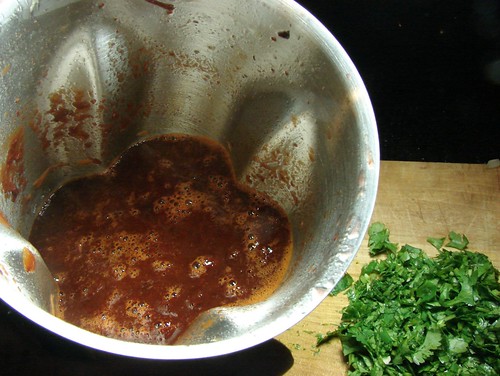
Heat a pan large enough to hold all of the chicken meat and add the olive oil, onions and garlic, cook until the onions are soft and translucent. At this point add the cilantro then the flour and stir constantly over medium heat, don’t let the flour burn, this will help thicken the sauce later. Add the saril puree and enough broth to make the sauce runny, about the consistency of half & half.

Once the sauce thickens a bit, to about the consistency of heavy cream, stir in the cream then add the chicken and lower the temperature to a slow simmer. Allow it to cook for 20-30 minutes, long enough for all the flavors to come together. Serve over white rice, maybe even pasta and be ready to be oh so happy!

To see just a few more pictures of the cooking goodness, go to my Flickr stream, here. Don’t forget to stop by Peter’s page while you’re there. Mil gracias, Pedro!!!
Cookingly yours,
Anamaris
Remember last year when my foodie obsession with Marx Foods began? I remember it like it was just yesterday, aahh that Mangalitsa ham *sigh*. Well, thanks to that very gorgeous piece of ham, I’ve been lucky enough to receive samples of their products as rewards for creating recipes. I’ve gotten so many goodies, it’s madness! The best part is that it allows me to stretch my foodie wings and palate and that makes me a better (and bigger) foodie, cook, aficionada, etc, etc.

Tellicherry Peppercorns from Marx Foods
I submitted recipes for more of their contests, which means I’ve gotten more goodies. I have a box of yummy things in my pantry. Since work has been so hectic, I’ve not had much time to experiment in the kitchen, even less time to share the results with you guys. But I’ve been dying to tell you about a couple of dishes I came up with using some of my loot. This post is not a very good step-by-step one. I blame it on work and exhaustion, that said, these two dishes are way too good not to share with you! Oh.eM.Gee!!! These were sooooo good! I’m drooling just thinking about them.
Keep in mind, many of the spices were gifts from the good
Marx Foods peeps, they are not paying me to say good things about them. What they do want is some honest feedback about their products and hopefully, if all is good, that may generate new customers for them. I know I’m onboard. OK, that’s my little disclaimer, on with the food!
I made two separate dishes for this evening, a Chayote and Mushroom Cream as an appetizer and, for the entrée, Beef Cheeks with Ancho & Guajillo Peppers over White Truffle Rice Cakes. Yeah. Uhuh. Sounds über
good, doesn’t it? I can’t tell you how good they both were, but I’m gonna try.
Let’s start with the soup. You probably know I’m a huge fan of chayote squash, it was one of the few veggies my Mami could get me to eat when I was a kid. As of late, I’ve been using them in a few new-to-me ways, you can find some really good recipes on my blog by doing a ‘chayote’ search. This little vegetable has a very mild taste most similar to a yellow squash IMO.
Chayote and Mushroom Cream
For the soup, I used a variety of dehydrated mushrooms, oyster, porcini and shitake, from Marx Foods. I steeped them in hot water for about an hour, then strained them out and used the reserved liquid to cook the chayotes. I ran the mushroom broth through a coffee filter to catch any grit–though there was none to be found.
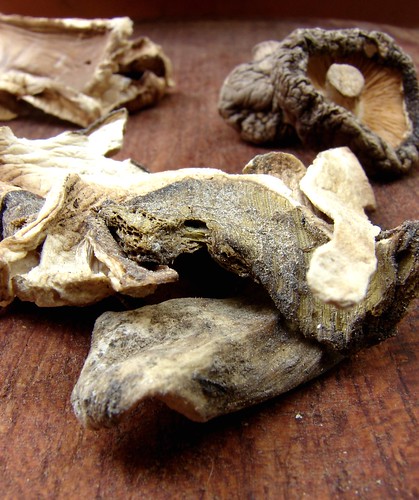
Oyster, Shitake and Porcini Mushrooms
I peeled and cubed 3 chayotes, then cooked them until tender in the mushroom broth (you may need to add a bit more water, just enough to cover the chayotes. The broth was seasoned with Smoked Salt. Once the chayotes are tender, run them through the blender to puree the soup. Return to the pot and add heavy cream, about 1/2 cp or to taste.

Smoked Salt and Tellicherry Peppercorns
While the chayotes cooked, I roughly chopped the mushrooms and sautéed them in 2-3 tbsp of butter. I added 1 tsp ground Tellicherry Peppercorns, more Smoked Salt and about 1/2 cp of dry sherry that was cooked into the mushrooms. Keep warm.
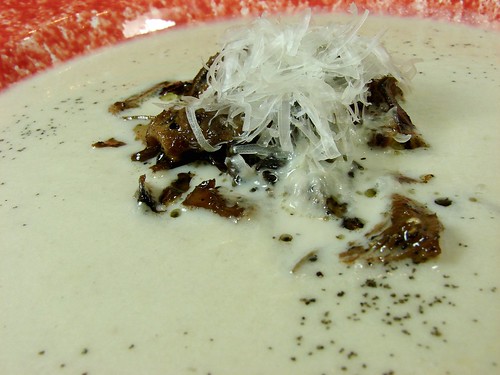
To plate: pour the cream in your bowl, top with a dollop of the sautéed mushrooms, a sprinkling of the Smoked Salt and grated Manchego or Parmesan cheese.
Now, what can I tell you about the entrée…??? I had never cooked beef cheeks before, but I find myself obsessed with them now. I will admit it isn’t one of those things you can make on the fly, because that meat needs to be brought into submission before making it magical. I certainly hope you give it a try, the rewards are indescribable. The meat is melt in your mouth tender and possesses a sweet unctuousness about it.

Ancho & Guajillo Chilies
For this recipe I finished the cheeks with Guajillo & Ancho Peppers and a bit of Fennel Pollen, this gave the final dish a perfect balance of sweet, savory and spiciness that had The Hubbz and I swooning over our plates. The above decadence sat atop rice cakes that had been laced with White Truffle Oil and cream before being crisped in butter.
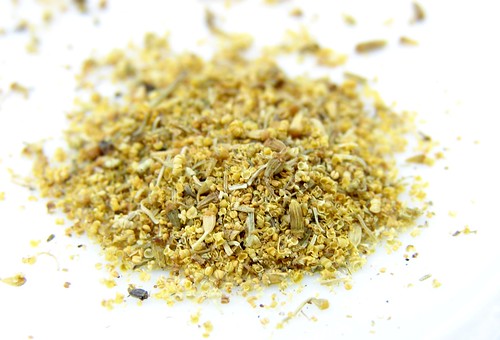
Fennel Polen from Marx Foods
The scent and taste of the Truffle Oil was so rich and intoxicating, it played beautifully against the other ingredients. I then channelled Iron Chef Symon and topped this concoction with a watercress salad that helped cut through this incredibly rich plate. Let’s get to it, shall we?
Beef Cheeks with Ancho & Guajillo Peppers and White Truffle Rice Cakes
To prepare the beef cheeks, I removed any excess fat and tendons early in the day, just before allowing it to braise for an hour or so in water that was seasoned with a couple cloves of garlic (peels and all), bay leaf, salt & pepper. Once tender, cut into cubes, but make sure to reserve the broth produced.
I simmered 2 guajillos and 2 anchos in about 1 cp of the reserved broth, just until they became soft, about 10-15 minutes. If you want to minimize the heat in the dish, remove the seeds before steeping the peppers. I allowed the peppers to cool just enough to handle and chopped them up and added them to a hot pan with about 1tbsp of extra virgin olive oil, followed by 2 tsps of Fennel Pollen, the zest of 1 orange, 1/4 cp of dry sherry, the cubed meat and seasoned with salt & pepper. I added enough of the reserved broth to simmer the beef until it was melt-in-my-mouth tender, about 30-40 minutes.
While the cheeks cooked, I added 1 tbsp of White Truffle Oil and 3 tbsp of heavy cream and 2 tbsp of finely chopped chives to about 2 cps of cooked leftover jasmine rice. I formed the mixture into 4 patties and placed them in the freezer for about an hour to make them easier to handle. Once they were firm on the outside, I ran them through a breading station: flour-egg-panko crumbs. These were then crisped in a skillet in a combo of butter and oil until golden brown.
I made a make-shift vinaigrette for the watercress, by combining the juice of the orange with a bit of Truffle Oil (probably less than 2 tsps), I dressed the watercress with the vinaigrette and a sprinkling of salt & pepper just before serving.

To plate: I placed 2 rice cakes on the plate, topped them with the beef braise and topped that with the watercress salad. Once you make this and take the first bite, you really will think you died and went on to happy orgasmic heaven.
About the Marx Foods ingredients aka The Loot:
Tellicherry Peppercorns: I love these and will be adding them to my pepper mill. Its black peppers on roids! Really big, bold peppery goodness. A must have.
Smoked Salt: I think it is really cool just to look at, but the flavor it adds to your food is surprising. It really makes it taste smoky. Really excited to have my hands on this one.
Dried mushrooms : These were good, but I wasn’t wild about the texture of them, it made me think of seaweed. I still have some left and will try them again, because I think I might’ve not reconstituted them properly. For now, I’m sticking to the fresh stuff.
Dried Guajillo and Ancho Peppers: I simply love these and I’m pretty familiar with them and have them available at almost every grocery store here in town. I did notice that these seemed ‘cleaner’?? Sometimes when I pick them up at the grocers here they look ‘dusty’ and I rinse them before use. The Marx peppers were ready to go.
Fennel Pollen: Yeah, another keeper. This was the second time I incorporated it into a recipe and I absolutely love it!
White Truffle Oil: This baby is sooo good, it should come with its own choir so that you here them chant ‘aaaaaaaaah’ everytime you open the bottle. Gimme, gimme!
There’s more Marx Goodness to come, so stay tuned.
Cookingly yours,
Anamaris
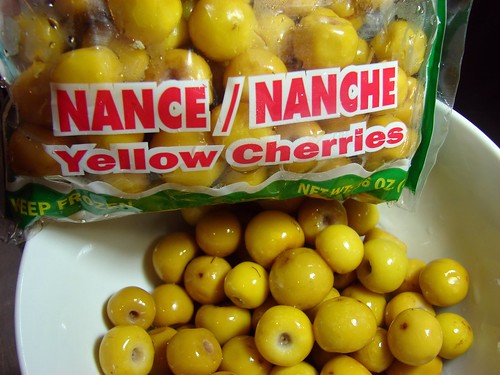
I’m not one to indulge in desserts too often, my sweet tooth is… lacking, but Flan is one of the few desserts I can’t keep my hands away from. Which means, I make it as infrequently as possible to keep that heart attack at bay.
I’m always reading about variations to flan, adding chocolate, pumpkin, coconut, it goes on and on. So, I thought of trying my own little tropical variation: Nance.
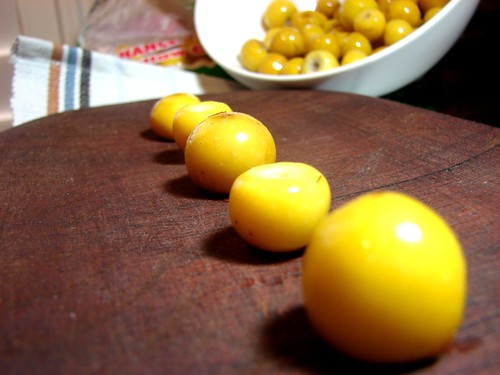
This is a very interesting little fruit, and it IS little, anywhere between the size of a blueberry and a cherry. In fact, they are known as yellow cherries in English. The fruit has some fat and is tart and becomes sweeter after picking. It grows on a tree and when they’re ready, they fall to the ground, collected, rinsed and thrown in a bottle with water for a few days. This allows them to ripen fully and develop its sweetness.
In order to get the pulp, you either have to use your hands and squish them or put them in the blender, liquid and all, and pulse them a few times to loosen the pulp. In this case, since the nance was sold in the frozen section of my grocers’, I thawed them and whirled them about in the blender with enough water to keep them moving. Strain and you’re ready to make a chicha–Panama’s pumped up fruit drinks, pesada or this to-die-for flan.
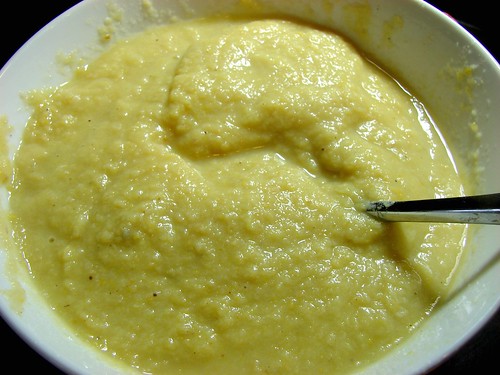
Flan de Nance
For the caramel sauce:
1-1/4 cp sugar
For the flan:
6 whole eggs
4 oz cream cheese
1-1/2 cps nance pulp
1/2 tsp almond extract
1 tsp vanilla extract
1/2 cp granulated (white) sugar
1/4 tsp sea salt (bit less if using regular salt)
1-1/2 cps whole milk
Preheat oven to 350°. Prepare a Bain-Marie: you will need a baking pan that is large enough to hold the dish you’re baking the flan in. Add hot water to the large pan and place in the oven.
To make the caramel, following the directions I gave you before for a cheese flan; here’s the link.
Making the flan: Put all the ingredients except for the milk in a blender glass and whisk until smooth. To avoid foaming the eggs, do this by pulsating instead of letting the blender go for a long time. It shouldn’t take more than 5-6 pulses.
In the meantime, use the same saucepan you used to make caramel to scald the milk. There will probably be some caramel stuck to the pot. That’s fine, just add the milk and simmer until you see bubbles beginning to form around the edges. Turn off and remove from the heat.
You will now incorporate the hot milk into the egg mixture, because the milk is pretty hot, start the blender on low and slowly drizzle in the milk/sugar mix. As soon as all the milk is added, turn off the blender. Pour the custard into the carameled baking dish. Place the dish with the custard into the pan with water.
If you bake it in a 9-inch dish, it will probably be in the oven for close to 45 minutes. You’ll know it is ready when the top is golden and it begins to separate from the sides, but there’s still a jiggle at the center. Remove from the oven and allow it to cool at room temperature for about 30 minutes, then put it in the fridge to cool it all the way through.
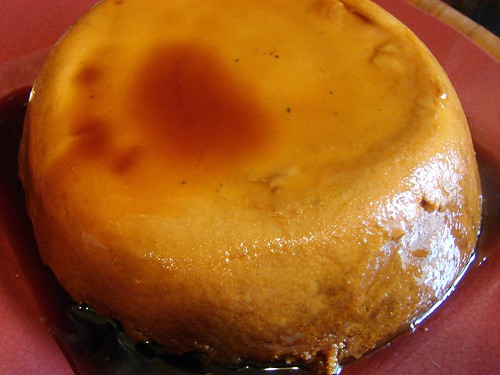
When you’re ready to serve, run a table knife around the edge to help loosen the cooled flan. Then invert it onto your serving dish. Make sure you invert over your sink, you’ll be amazed at how much of that caramel melts away onto your serving dish and continues running down your arm and on the clean floors.
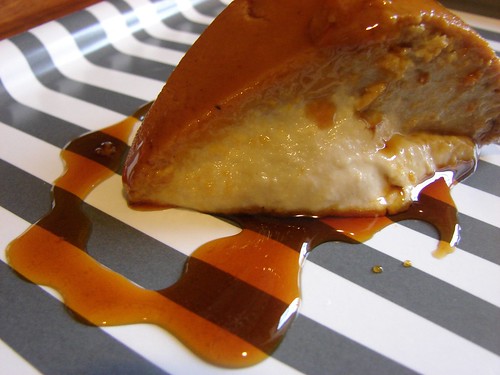
Cookingly yours,
Anamaris

Have you ever rediscovered the value of something long forgotten? Reacquainted yourself with an old friend? Isn’t it the best feeling in the world? I’ve had this little Panamanian cookbook for over 20 years–it has the wear, tear and stains to prove it–I think I’ve only pulled it out about 3 times a year for each year I’ve lived here. That’s like 60 uses in over 7,000 days! Crazy!
The cookbook is by Berta de Peláez, a well-known Panamanian cook and TV personality. She is Panama’s answer to Martha Stewart. I remember watching her show every morning with my Mami and my sister. Later my sister and I would get in the kitchen and re-enact our own show. Me as Berta, my sis as Maria, the assistant. Fun times!
Can you imagine how silly I felt after finding this little recipe? It really is a trifecta of goodness: rice, shrimp, garlic. Queue choir chants: AAAAAAAAAAAAAAAH” Yes. It is that good. It is also incredibly easy to make and terribly quick. Did I say it was DELICIOUS? Because it was. Yep. To die.

It’s almost like a fried rice, except you fry the rice in butter (my adaptation, because butter makes everything bettah) and add a generous amount of garlic. I had some leftover steamed rice from my delivery order of Chinese food, and that’s what I used. You could also make some fresh rice for this, but let it cool a bit before putting it all together. Ready? This is gonna go pretty fast!
Arroz al Ajillo (Garlic Rice)
adapted from El Arte de Cocinar
1/2 medium shrimp, peeled & deveined
1 tsp smoked paprika
3/4 tsp sea salt
1/2 tsp black pepper
1/4 cp bacon, diced
4 tbsp butter
3-5 garlic cloves, crushed
3 green onions, diced
3 cps rice, cooked
I opted to slice the shrimp in half, lengthwise. Not sure why, but that’s what I did. Season the shrimp with the paprika, salt and pepper and set aside.

In a medium-sized pan, cook the bacon until crisp. Add the shrimp and cook them for a couple of minutes just until they don’t look translucent. Add 2/3 of the green onions. Remove the shrimp and bacon from the pan with a slotted spoon, leaving the bacon fat behind.
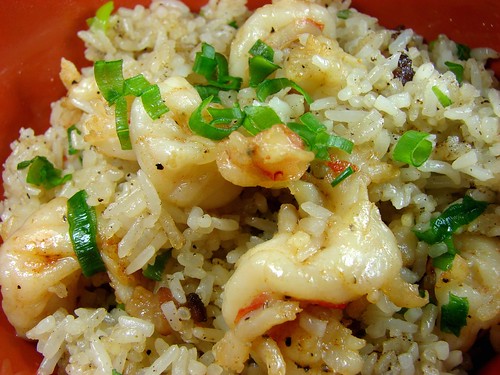
In the same pan, add the butter, once melted add the garlic and give it a quick stir. Don’t let it burn. Add the rice and stir well to make sure it is all coated with the garlic butter. Incorporate the shrimp, toss and serve topped with the rest of the green onions.
How do you like THAT?!
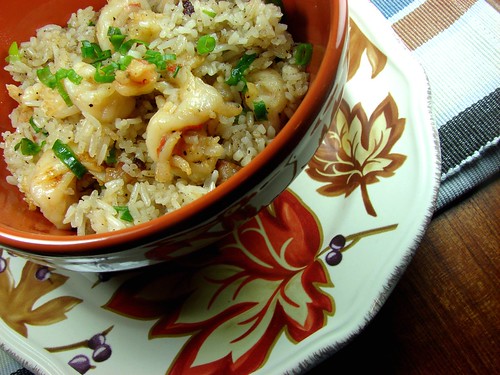
Cookingly yours,
Anamaris
Around the holidays, I made some Mexican tamales, those were oh so good, we’re still eating on them. But I had a bit of the corn masa leftover… oh, what to do? What to do? The Hubbz loves Salvadorian pupusas and has been asking me to try my hand at them for a while. Leftover masa? Perfect opportunity.

White corn is very popular throughout all of Central America, except for Panama. In my little country, yellow corn is king, the white variety wasn’t really known until recent years.
Pupusas, a funny name for the Spanish speakers, but a seriously delicious treat. Salvadorian pupusas are similar to Venezuelan arepas and Mexican gorditas, except that pupusas are filled, then grilled. A sort of round corn empanada, really. Most commonly, you’ll find these filled with chicharrón (fatty, crisp pork), cheese and black beans. However, fillings are only limited by the cook’s imagination.

I opted to go for the cheese and chicharrón filling. Since I had rendered some pork fat, I was in possession of some choice pork cracklings and there’s ALWAYS queso fresco in da’ house! Check it out:
Pork & Cheese Pupusas
I mixed some of the fresh masa with a bit of pork lard and seasoned it with salt. It isn’t necessary to add either of those things, but I find the corn masa to be bland and dry and I wanted a flavorful, moist pupusa. If you’re using dry masa, simply follow the packaging instructions and add enough water to have a somewhat soft and pliable dough, season or not as you prefer. Shape the masa into balls.
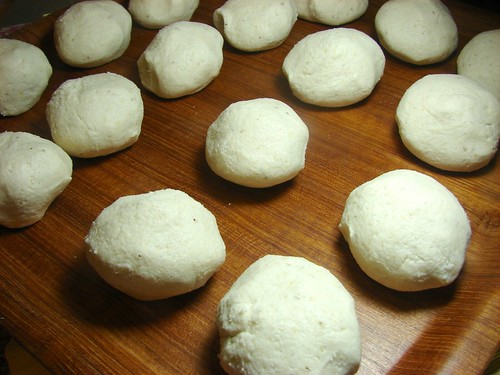
Then flatten and begin adding the filling. I’ve seen this done from a single ball that is stuffed and flattened, but I found it a lot easier to use 2 flatten balls, put the filling on top of one and top with the other half. Seal the edges by pinching them together.
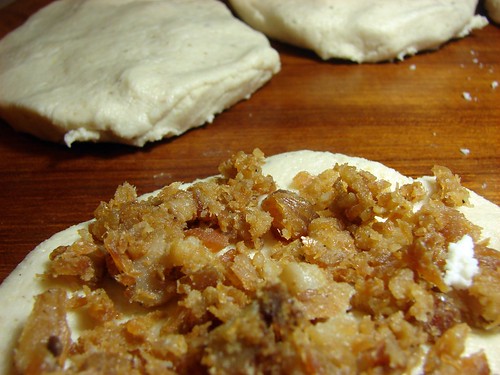
If you have a comal or a cast iron skillet, that’s the best way to grill these. If not, any non-stick skillet will work. Brown on each side over medium temperature. You want to make sure the dough cooks through and the filling is warmed up, so watch the temperature. They should sound kinda hollow when you thump them, that’s how I know they’re cooked through.

Typically, these are served with curtido, a pickled cabbage salad. I’m not a cabbage fan, but I did have pickled carrots and I made a dipping sauce with crema fresca and homemade salsa. Yum!

Here’s more pupusa action here.
Cookingly yours,
Anamaris
I told you there would be an opportunity for you to play along in the Marx Foods challenge. It’s about that time, my friends. Voting time. Go check out all the incredible entries for the Ridiculously Delicious Challenge, there’s some really good stuff there. Then pick a recipe and vote for it. 15 participants will move on to the next round. Hurry, go vote!
aaaaaaaand…, it’s Wednesday! That means I have an entry for Shutterboo’s photo challenge. The theme this week was Large. What do you think? Go here to see this week’s submission.

There were rides and games.

Largely yours,
Anamaris
PS: Don’t forget to vote!
































